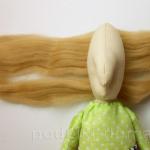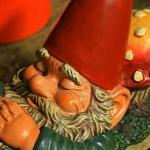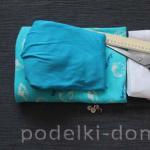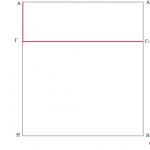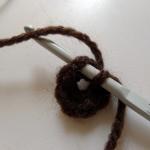Do-it-yourself amulet doll “Baba Yaga”. Good Baba Yaga from a plastic bottle and tights (MK) Make Baba Yaga with your own hands from


Whether you braid your hair or create tousled hair depends on the image of Baba Yaga you are creating. We tie the scarf on the head so that the knot is in front.


If desired, Ezhka can wear a vest and hang beads around her neck.

In this master class, the fairy-tale heroine was given a broom in one hand and a bag with the inscription “Luck” in the other. The whisk was made from ordinary thin branches wrapped with twine around a sushi stick.


The bag is very easy to sew. A rectangle is cut out of a piece of fabric, sewn along the edges, filled with padding polyester, and pulled together at the top. The inscription (“Luck”, “Happiness”, “Wealth”, etc.) is written on a separate piece of fabric, which is then glued or sewn onto the bag.
So we sewed a charming and youthful Baba Yaga:

Did you like the product and want to order the same from the author? Write to us.
More interesting:
Send your photos
Do you also make beautiful crafts? Send photos of your work. We will publish the best photos and send you a certificate of participation in the competition.See also.
Most people associate Baba Yaga with evil: she threatens to fry, eat, ride on bones, she doesn’t want to accept a traveler, she forces girls to work. But the image is used as a talisman. Let's figure out how to do this.
Her appearance frightens and repels her: a huge crooked nose, large iron teeth, gray tangled hair, one leg made of bone or gold. She knows evil spirits, keeps magical objects and secret knowledge, and lives in a dense forest in a hut on chicken legs. Her house is surrounded by a fence made of human bones, and the gate is locked by a human jaw. At night, the courtyard is illuminated by skulls with glowing eyes. He moves in a mortar and covers his tracks with a broom. She is helped by geese-swans and four horses: morning, day, evening and night. This is how Russian fairy tales describe Baba Yaga. There are no unnecessary details in her image. Several roles can be distinguished:
- A guide to the land of ancestors, the concentration of the wisdom of the family. IN In people's minds, Baba Yaga is located on the border of the worlds of the living and the dead. The witch can communicate with the spirits of ancestors and helps a person cross the border into the land of the dead. That’s why they were afraid of her: anything connected with death inspires fear. But in the fables, the good fellow accidentally or on purpose found Yagusi’s hut. The meeting in any fairy tale ends well. The guest received advice, a magical item, or was transported across a fiery river to the other world. This point is connected with the beliefs of the ancient Slavs in the power of the clan. Every worthy person after death ended up in Heavenly Svarga (a country in the sky). From there, together with other ancestors, he monitored life on earth and, if necessary, provided support. People in difficult situations turned to their ancestors. The one who honored the roots received all the benefits of the earth. That’s why the good guys went to Yaga. In some fables, she herself is the personification of the help of her ancestors. Baba Yaga is angry, intractable, threatens to eat her and is dissatisfied that “the Russian spirit came to her on its own,” but there is no tale that talks about being eaten, only threats. All guests received help by going through a series of tests.
- The ancestor of the family, mother. Some Slavic peoples call her Mother Yaginya, who performed initiation ceremonies. Let us remember the fables where the beautiful maiden ended up in a hut on chicken legs. The girl worked hard: she cooked, cleaned, heated the bathhouse, carried water, weaved and spun. After work, I scratched Yaguse’s heels so that she could sleep sweeter. According to some researchers, Baba Yaga prepared girls morally for married life in this way, checking how ready they were for independent housekeeping. Everyday women's work is a hard routine that is mentally and physically exhausting. Yaga’s task is to teach the girl the right attitude to work. It should be like priestly service. And learning about motherhood and raising offspring is the highest act of serving God. Baba Yaga is the guardian of the family institution. The theft of boys is associated with a rite of passage into hunters. The boys were put to the test in the forest and their knowledge was tested.
Witch and healer. To do this, let us remember how Baba Yaga threatened to fry the children in the oven and even tried to make Ivanushka sit on a shovel. This is a reminder of the ancient ritual of baking a child. It was customary to wrap sick and weak children in dough and send them to warm themselves in the oven on a bread shovel. It was believed that this symbolizes a second birth, because the mouth of a Russian stove is like a mother’s womb. The sick person’s ailments were blown out into the chimney and the child was healed and became strong.
Witchcraft attributes are not random. They indicate a connection with the world of the dead and her witchcraft abilities.
- The hut resembles the smoking hut of the Slavs. This is a house for the ashes of the dead, which were placed on stumps resembling bird feet.
- A special ritual was performed for uninvited guests. The hero must persuade the hut to stand in front of him. To do this, he explains why he came. Afterwards they fed and gave water and steamed in the bathhouse - elements of the funeral rite.
- Geese-swans are guides to the afterlife.
- Skulls and bones serve her in controlling the forces of nature.
- Baba Yaga's broom is a symbol of purification.
- Shaggy hair is a magical attribute. They attract cosmic forces and energy. So in Rus' either witches or libertines walked.
- She did not wear a belt, since the belt is protection from spirits and evil forces. Yagusa did not need to defend herself.
It turns out that she is a sorceress, mother, ancestor and ruler of the family, who lives for a long time and has accumulated knowledge and wisdom, and therefore has become decrepit and fearful. This image is an echo of matriarchy, when the woman played the main role and controlled everything. Later the roles changed, but the memories remained and came to us in fables. But the symbol changes and acquires details. Most Russian folk tales have been rewritten, so many features are missing and parallels with what we have described are difficult to draw. It is better to read fairy tales published before the mid-20th century.
The meaning of the amulet
A strong image is now used as a talisman. Its meaning:
- For the well-being of the family. Yaga is the keeper of family traditions, so she will bring peace, harmony and order to the family.
- Helps you make the right decision, solve a problem, and understand your purpose.
- Relieves ailments.
- Clears the house of negative energy and quarrels.
- Protects from witchcraft, damage and the evil eye.
The talisman is always given to those who often quarrel with household members, not finding a common language, who are sick, who have lost their purpose and cannot decide on the choice of their favorite business and profession, or are confused in problems. The ancestors of the family will come to her aid.
Do-it-yourself Baba Yaga amulet
We offer an option based on a folk doll. This method is good because it’s simple: you don’t need a sewing machine or a needle. The work takes no more than an hour.
Before starting the master class, let’s remember the rules for making a protective doll. They are needed for the talisman to be kind and strong. Any deviation from tradition will negatively affect the doll’s energy.
- Do not use scissors or needles. Fabrics are torn by hand; it is better to take thin and pliable materials. For example, chintz or calico. The threads are chewed or annealed over a candle.
- The face is not painted on the doll so that spirits do not possess it.
- Do not sit down to work in a bad mood, when feeling unwell, or on critical days.
- While working, do not get distracted by TV, conversations or extraneous thoughts.
- When making a doll, you need to be focused, send your thoughts and energy to it. You can read the plot, but it’s better to just talk, talking about your problems, plans and hopes.
- The doll is made in one go, without stretching the work over the whole day.
- The number of knots and turns must be even.
- If the work is not going well, then it must be postponed. Perhaps the help of such a talisman is not needed now.
In addition, you must believe in the power of the amulet and the family. Otherwise he won't help.
Description of the master class
For work you will need the following materials:
- Scraps of multi-colored fabric.
- White or beige fabric for the body.
- Stuffing: padding polyester, padding polyester, half-fiber, cotton wool.
- Yarn or tow for hair. In our case, felting felt.
- Match or stick.
- Threads.
- Twigs for a broom.

Let's get to work. The sizes are not indicated so that each needlewoman makes her own special doll.
- We make a square from a white scrap. We put a match in the center of it.

- Wrap the match in fabric and tie it with thread. This is the nose. You can pull it forward like a beak.

- We stuff the head, giving it shape. At this stage, the chin and cheeks are formed. Redistributing the folds will help with this. The fabric is tied at the back with thread.

- We fold the fabric over the body in a similar way. The denser and thicker the body, the more stable the doll. This is why this addition is necessary. The bottom will be thicker and the doll will not roll over.

- We twist it and wrap it with threads. This fixes the fabric and gives it rigidity.

- We attach the head. Baba Yaga is hunched over, so we wrap our head with a slight tilt forward.

- Cut out two colored rectangles and two white squares. These are future hands.

- Fold the white piece diagonally. Fold the resulting triangle in half and in half again. The figure resembles a blank for a snowflake. These are palms.

- We wrap the palm with the tip inside the rectangle and secure it with thread.

- Turn the product inside out.

- We tie our hands to the body. To enhance the feeling of the hump, we attach the arms closer to the chest.


- It's time for clothes. You can choose any outfit: a sundress, a skirt with an apron, a vest, or simply indistinguishable rags. The principle of forming an outfit is one. In our case, Baba Yaga is wearing a long shirt and skirt. We wrap the skirt from the inside out. For pomp, folds are formed.


- We apply hair to the head. It is most convenient to take felt. It holds well, does not slip and is very similar to gray hair. The hair is secured with a scarf. It can be tied according to Ukrainian custom with a knot on the forehead or traditionally with a knot back, covering the neck.


BABA YAGA... WHO IS SHE?
V.Ya. Propp. Historical roots of fairy tales (fragments)
Yaga is a very difficult character to analyze. Her image is made up of a number of details. These details, put together from different fairy tales, sometimes do not correspond to each other, do not combine, do not merge into a single image. Basically the fairy tale knows three different forms of yaga. She knows, for example, the giver yaga to whom the hero comes. She questions him, from her he (or the heroine) receives a horse, rich gifts, etc. Another type is the kidnapping yaga. She kidnaps children and tries to fry them, followed by escape and rescue. Finally, the fairy tale also knows a warrior yaga. She flies to the heroes' hut, cuts a belt from their back, etc. Each of these types has its own specific features, but in addition there are features common to all types. All this makes research extremely difficult.
Walking “wherever they look,” the hero or heroine ends up in a dark, dense forest. The forest is a permanent accessory to the yaga. Moreover, even in those fairy tales where there is no yaga (for example, in the fairy tale “Kosoruchka”), the hero or heroine still certainly ends up in the forest. The hero of a fairy tale, be it a prince or an exiled stepdaughter, or a runaway soldier, invariably ends up in the forest. This is where his adventures begin. This forest has never been better described. It is dense, dark, mysterious, somewhat conventional, and not entirely believable.
Here, a whole ocean of materials related to ideas about the forest and its inhabitants opens up before the researcher. In order not to get lost here, you must strictly adhere to only those ideas that are associated with the fairy tale. Thus, goblin and mermaids are almost not reflected in the fairy tale. The mermaid appears only once in the entire Afanasyev collection, and then in a saying. The goblin is always nothing more than a renamed yaga. The closer the connection between the fairytale forest and the forest that appears in initiation rites. The initiation ceremony was always performed in the forest. This is a constant, indispensable feature of it throughout the world. Where there is no forest, children are taken at least into the bush. 

The forest as a separate isolated element does not prove anything. But that this forest is not entirely ordinary can be seen from its inhabitants, and can be seen from the hut that the hero suddenly sees in front of him. Walking “wherever his eyes look” and accidentally raising his gaze, he sees an extraordinary sight - a hut on chicken legs. This hut seemed to be familiar to Ivan for a long time: “We’ll climb into you, eat bread and salt.” He is not at all surprised by her and knows how to behave.
Some fairy tales say that this hut “spins,” that is, it rotates around its axis. “In front of her stands a hut on chicken legs and constantly turns around” (Aph. 235). “It stands and turns” (K. 7). This idea resulted from a misunderstanding of the word “turns.” Some fairy tales clarify: when necessary, it turns. However, it does not turn by itself. The hero must make her turn, and for this he needs to know and say the word. Again we see that the hero is not at all surprised. He doesn't mince words and knows what to say. “According to the old saying, according to my mother’s saying: “Hut, hut,” said Ivan, blowing on it, “stand with your back to the forest, with your front to me.” And then the hut turned to Ivan, a gray-haired old woman was looking out of the window” (Af 560). “Hut, hut, turn your eyes to the forest, and turn your gates to me: I will not last forever, but last a night. Let the passerby in” (K. 7).

What's going on here? Why do you need to turn the hut? Why can't I just log in? Often in front of Ivan there is a smooth wall - “no windows, no doors” - the entrance is on the opposite side. “This hut has no windows, no doors, nothing” (17). But why not go around the hut and enter from the other side? Obviously this is not possible. Obviously, the hut stands on some kind of visible or invisible edge that Ivan cannot step over. You can only get to this edge through the hut, and the hut needs to be turned “so that I can get in and out” (See 1).
The open side of the hut faces the thirtieth kingdom, the closed side faces the kingdom accessible to Ivan. That is why Ivan cannot go around the hut, but turns it around. This hut is a guard post. He will not cross the line until he is interrogated and tested to see whether he can go further. Actually, the first test has already been passed. Ivan knew the spell and managed to blow on the hut and turn it.
We will continue to follow the actions of the hero. The hut has turned, and the hero enters it. He doesn't see anything yet. But he hears: “Fu, fu, fu! Before, the Russian spirit was unheard of, unseen; today the Russian spirit sits on a spoon and rolls into its own mouth” (Af. 137). “The Russian spirit came to my forest!” (North 7). Or in short: “Ugh, how Russian bone stinks” (Af. 139). We need to dwell on this detail. It is very significant.
However, as soon as we turn to comparatively earlier stages, we immediately receive the key to our motive. This material shows that Afanasyev was not mistaken in asserting that Ivan’s smell is the smell of a person, and not a Russian. But his statement can be clarified. Ivan smells not just like a person, but like a living person. The dead and incorporeal do not smell, the living smell, the dead recognize the living by their smell.
The smell of Ivan is the smell of a living person trying to penetrate the kingdom of the dead. If this smell is disgusting to the yaga, then this is because the dead generally experience horror and fear of the living. No one alive should cross the cherished threshold.
The canon of the fairy tale requires that the exclamation “Fu, fu, fu,” etc. be followed by an inquiry about the purpose of the trip: “Are you torturing for business or flying for business?” We expect the hero to now reveal his goal. The answer he gives must, however, be recognized as completely unexpected and not resulting from the threats of the yaga. First of all, he demands to eat. “Why are you shouting? First, give him something to drink and feed, take him to the bathhouse, and then see him out and ask questions” (Af. 105). And, what is most extraordinary, the yaga completely humbles herself with such an answer: “Baba Yaga gave them something to drink, fed them, and took them to the bathhouse” (105). “She got down and bowed low” (137).
Note that this is a constant, typical feature of yaga. She feeds and treats the hero. Let us also note that he refuses to speak until he is fed.
What is this? Why do heroes never eat, for example, before leaving home, but only at the yaga? This is not an everyday, not a new-realist trait, this trait has its own special history. Food has a special meaning here. By demanding food, the hero thereby shows that he is not afraid of this food, that he has the right to it, that he is “real.” That is why the yaga submits to his demand to give him food.

We now turn to consider the yaga itself. Her appearance is made up of a number of particulars, and we will consider these particulars first separately, and only after that we will consider her figure as a whole. The yaga itself appears in two forms: either when Ivan enters, she lies in the hut - this is one yaga, or she flies in - this is a yaga of another type.
Yaga the Giver is in the hut when Ivan arrives. First of all, she is lying down. It lies either on the stove, or on a bench, or on the floor. Further, she occupies the entire hut. “There is a head in front, a leg in one corner, another in the other.” (Aph. 102). “Baba Yaga lies on the stove, a bone leg, from corner to corner, her nose rooted in the ceiling” (137). But how do you mean “your nose has grown into the ceiling”? And why does the yaga take up the entire hut? After all, she is nowhere described or mentioned as a giant. And, therefore, it is not the hut that is big, but the hut that is small. Yaga resembles a corpse, a corpse in a cramped coffin or in a special cage where they are buried or left to die. She is a dead man.
The Russian yaga does not have any other signs of a corpse. But Yaga as an international phenomenon possesses these characteristics to a very wide extent. “They are always characterized by the attribute of decomposition: a hollow back, softened meat, brittle bones, a back, pitted
eaten by worms" (Guntert). 
If this observation is correct, then it will help us understand one constant feature of the yaga - bone-footedness. To understand this feature, we must keep in mind that “awareness of a corpse” is a very late thing. In the earlier materials from America that we have already cited, the guardian of the kingdom of the dead is always either an animal or a blind old woman - without signs of a corpse. Analysis of the yaga as the mistress of the kingdom of the forest and its animals will show us that her animal form is her oldest form. She sometimes appears like this in Russian fairy tales. In one Vyatka fairy tale by D.K. Zelenin (3B 11), which is generally replete with extremely archaic features, the role of a yaga in a hut is played by a goat. “The goat lies on the beds, the legs are on the beds,” etc. In other cases, it corresponds to a bear, a magpie (Aph. 249, 250), etc. But the animal never has a bone leg, not only in Russian material (which could be explained by phenomena of language - “yaga” rhymes with “leg”), but also in international material. Consequently, the bone leg is somehow connected with the human appearance of the yaga, connected with its anthropomorphization. The transitional stage from animal to man is a man with an animal leg. A yaga never possesses such a leg, but Pan, fauns and a motley line of all evil spirits possess such legs. All kinds of elves, dwarfs, demons, devils have animal legs. They retain their animal legs just as the hut preserved them. But at the same time, yaga is so firmly connected with the image of death that this animal leg is replaced by a bone leg, that is, the leg of a dead person or skeleton. The bone-footedness is due to the fact that the yaga never walks. She either flies or lies, that is, she outwardly manifests herself as a dead person.
Yaga gradually becomes clear to us as the guardian of the entrance to the thirtieth kingdom and at the same time as a creature associated with the animal world and the world of the dead. She recognizes the hero as a living one and does not want to miss him, warns him of dangers, etc. Only after he has eaten does she show him the way. She recognizes Ivan as if he were alive by his smell. But there is another reason why the yaga perceives Ivan by smell. Although this is never said in the Russian fairy tale, it can still be established that she is blind, that she does not see Ivan, but recognizes him by his smell. This blindness was, by the way, already suggested by Potebnya. He explains this blindness as follows: “Yaga seems, by the way, to be blind. One can guess that Baba’s blindness means ugliness. The idea of darkness, blindness and ugliness are akin and can replace one another.” This is proven by analysis of the root “lep” in Slavic languages (Potebnya). This conclusion of Potebnya is incorrect simply because she is blind not only on Russian or Slavic soil. The blindness of creatures like Yaga is an international phenomenon, and if we were to take the path of studying the etymology of a name or word for the phenomenon denoting it (which is always very dangerous and often incorrect in essence, since the meaning changes, but the word remains), then it would be necessary to study a comparative study of the designation of blindness in different languages. None of them will lead to the name of the yaga. But such an analysis might show that “blindness” does not simply mean the absence of vision. Thus, the Latin caecus not only means active blindness (unseeing), but also, so to speak, passive (invisible - caeca nox - “blind” night). The same can be deduced regarding the German ein blindes Fenster.
So, an analysis of the concept of blindness might lead to the concept of invisibility. A person is blind not in himself, but in relation to something. Under "blindness" the concept of a certain reciprocity of invisibility can be revealed. In relation to Yaga, this could lead to a transfer of the relationship of the world of the living to the world of the dead: the living do not see the dead in the same way as the dead do not see the living. But, one might argue, then the hero would also have to appear blind. Indeed, this is how it should be, and this is how it actually is. We will see that the hero who ends up with the yaga becomes blind.
But is Yaga really blind? This is not directly visible, but it can be judged by some indirect signs. In the fairy tale “Baba Yaga and Zhikhar,” the yaga wants to kidnap Zhikhar and flies to him at the moment when his friends and roommates, the cat and the sparrow, have gone to get firewood. She starts counting spoons. “This is the cat’s spoon, this is Vorobyov’s, this is Zhikhar-kova.” Zhikharko could not stand it, he roared: “Don’t touch my spoon, Baba Yaga!” Baba Yaga grabbed Zhikharko and dragged him away,” (Af. 106). So, to find out where Zhikharko is, the Yaga must hear his voice. She doesn’t look out, she listens, just as she sniffs out an alien. 
Another feature of the yaga's appearance is her sharply emphasized feminine physiology. Signs of gender are exaggerated: she is depicted as a woman with huge breasts:
“Tits through the bed” (Onch. 178. The bed is a pole for towels, etc.); “Yaga Yagishna, Ovdotya Kuzminishna, nose to the ceiling, tits across the threshold, snot across the garden bed, raking up soot with her tongue” (Sm. 150). Or: “On the stove, on the ninth brick, lies Baba Yaga, a bone leg, her nose has grown into the ceiling, snot is hanging over the threshold, her tits are wrapped on a hook, she is sharpening her teeth.”
So, Yaga is equipped with all the signs of motherhood. But at the same time, she does not know married life. She is always an old woman, and an old woman without a husband. Yaga is not the mother of people, she is the mother and mistress of animals, moreover, forest animals. Yaga represents the stage when fertility was thought through a woman without the participation of men. Hypertrophy of the maternal organs does not correspond to any marital functions. Maybe that is why she is always an old woman. Being the personification of gender, she does not live the life of gender. She is already only a mother, but not a spouse either in the present or in the past. True, in the fairy tale she is never called the mother of animals. But she has unlimited power over them. 
It is widely believed that the yaga is a character who is typically given difficult tasks. This is true only for women's fairy tales, and even then it can be shown that these tasks are mainly of late origin. A man is given tasks much less often, rarely at all, and they are very few in number. Usually the reward follows immediately after the dialogue. ""You can hardly get it! Shall I help" - and gives him his horse" (Aph. 174). “She fed him, gave him something to drink and gave him Zolotitsa Mare” (Sev. 46). There are many such cases that can be cited; this is a typical form. The question arises: why does the yaga reward the hero? Outwardly, artistically, this award is not motivated. But in the light of the materials given above, we can say that the hero has already passed a number of tests. He knew the magic of opening doors. He knew the spell that turned and opened the hut, he knew the magic of gestures: he sprinkled the door with water. He made a propitiatory sacrifice to the beasts guarding the entrance. And, finally, the most important thing: he was not afraid of the yaga’s food, he himself demanded it, and thereby forever joined himself to the host of otherworldly creatures. Questioning follows the test, and reward follows the questioning. This also explains the confidence with which the hero carries himself. In what he sees, not only is there nothing unexpected, on the contrary, everything seems to have been known to the hero for a long time, and is exactly what he expected. He is confident in himself due to his magical weapons. This armament itself is really not motivated by anything. Only occasionally do we meet such characters as an aunt instructing a girl on how to behave with a yaga. The hero knows all this because he is a hero. His heroism lies in his magical knowledge, in his strength.

About Baba Yaga from other sources
Fairy-tale character Baba Yaga. Master class with step-by-step photos.
The work was carried out by Arina Fedoseeva, a student of class 1 “A” at MBOU gymnasium No. 69 in the city of Krasnodar.Supervisor: Goncharova Anna Anatolyevna, primary school teacher at MBOU gymnasium No. 69 in the city of Krasnodar.
Description: The master class is intended for joint activities of preschool and primary school children and teachers and parents.
Purpose: toy, souvenir, gift, decorative element of the interior.
Target: make a fairy-tale character - Baba Yaga with your own hands.
Tasks:
- teach how to make Baba Yaga with your own hands;
- master simple and interesting ways of making various parts from waste material;
- teach how to work carefully with glue;
- introduce safety precautions when working with scissors;
- develop fine motor skills of the hands;
- cultivate artistic and aesthetic taste, interest in work;
- develop the child’s imagination and fantasy;
- cultivate perseverance and accuracy.
In the fairy-tale story “Kuzka the Little Brownie” by T.I. Alexandrova, which Arina recently read, there was an unusually charming Baba Yaga! And we decided to make a doll to role-play the fairy tale.
Baba Yaga is the most striking character in Russian fairy tales. She is cheerful, and unpredictable, and kind, and evil, and even insidious! Baba Yaga lives in a hut on chicken legs, and uses a broom to fly!

Materials required for work: brown woolen threads, cotton wool, flesh-colored nylon golf, scissors, glue, the top of a plastic bottle, felt in four colors (red, blue, white, brown), fabric, two plastic forks.
Progress:

We put a flesh-colored nylon golf course on the neatly trimmed top of a plastic bottle. We tie the neck of the bottle with woolen thread, and fill the upper part of the golf with cotton wool and give it the shape of a head.

We make hands from two plastic forks: after carefully cutting off the edges, we wrap each fork with cotton wool.

Then we cover it with nylon golf and sew it up. We tighten each tine of the fork with a thread so that it looks like the fingers of a hand.

Now we make the nose: we cut off the elastic from the nylon golf, stuff it with cotton wool and sew it on.

We cut out eyes from blue felt, and pupils from white felt. Glue on Baba Yaga's eyes!

We cut out a fairytale smile from red felt.

Now we glue the finished arms to the body.

Let's make hair: wrap a skein around your palm and tie it. Cut the skein on the other side and straighten it.

Glue the hair to the head.

We make a skirt from brown fabric (we used an old knitted scarf).

Made from orange fabric - a blouse! We wrap the fabric around the upper body and arms and secure the fabric. Now tie the scarf and the outfit is ready! Our Baba Yaga is a fashionista!

Now let's make a fairy broom. We roll a tube out of brown felt and secure it with glue.

We cut wool threads of the same length - about 10 cm. We tie the threads to a felt tube.

Unscrew and tie again. The broom is ready!

There is a hut at the edge of the forest,
There's an old lady who lives there
For many, many years now,
And she has no friends.
Here the hut is spinning
As that old lady wishes.
Turns his back to the forest
And the old lady is very happy.
On the broom every night
She doesn't mind flying...

I can't fly without a broom,
There is nothing to cover the tracks with.
Woe, woe for Yaga,
If she doesn't have a broom.
Look at me,
Well, why am I not beautiful?
My maiden beauty
Can't help but like it!

